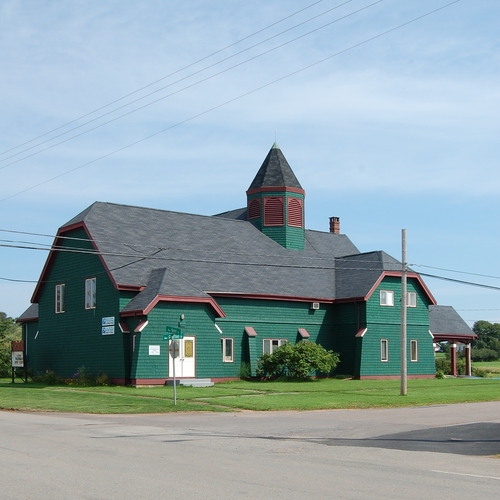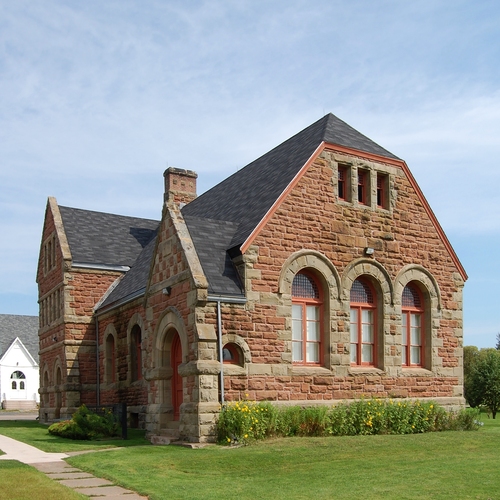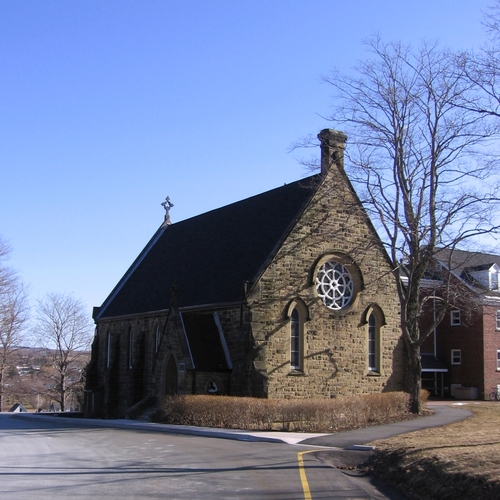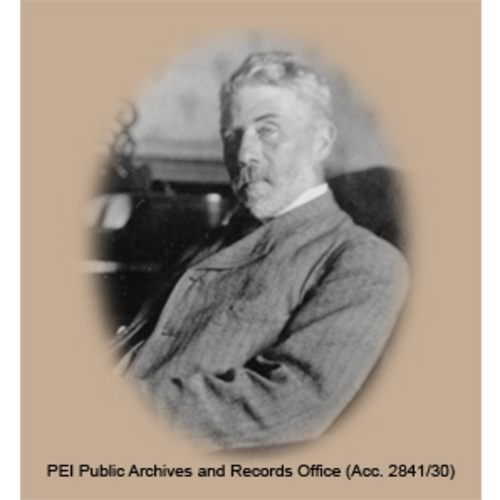HARRIS, WILLIAM CRITCHLOW, architect; b. 30 April 1854 in Bootle, England, son of William Critchlow Harris and Sarah Stretch; d. unmarried 16 July 1913 in Halifax.
William Harris was brought to Prince Edward Island in 1856 by his parents, with four siblings. After schooling in Charlottetown he was in 1870 apprenticed to architect David Stirling* in Halifax. Among his first commissions in Charlottetown after his return in 1875 was Beaconsfield, a 25-room mansion which is today the headquarters of the Prince Edward Island Museum and Heritage Foundation. In 1877 Stirling moved to Charlottetown and formed a partnership with Harris, who four years later became an associate of the Royal Canadian Academy of Arts.
In 1882 an economic slow-down at home prompted Harris to move to Winnipeg. After placing second in 1883 in a competition to design a new city hall, he accused the successful firm, Barber and Barber, of “architectural trickery,” provoking the retort from Charles Arnold Barber “Though you should work like the proverbial animal (somewhat resembling the horse but better fitted for comparison with yourself the jackass) you shall never succeed in putting yourself up with the goose quill.” In the same year depression put an end to construction in Winnipeg, and Harris was reduced to sleeping on a mattress in his office. A fire in Charlottetown in February 1884 destroyed part of the business district, and the young architect returned home to assist in the rebuilding. Thereafter his practice was confined to the Maritime provinces, although occasionally he entered competitions further afield – for example, for the Montreal Board of Trade building in 1891, in which he placed first among Canadian architects. He remained in Charlottetown until after his father’s death in 1899, when he moved to Halifax and acquired as partner a former builder, William T. Norton.
Harris’s specialty was churches. He was a High Victorian Gothicist who developed a distinctive style by blending elements from a variety of sources within the Gothic tradition. His approach never became fixed, but was continually changing and unfolding out of itself under the stimulation of contemporary trends and his own reflection. After designing churches based on English Gothic precedents in his early years (as, for example, St James’s Anglican Church at Mahone Bay, N.S., built for his brother the Reverend Edward Alexander Harris in 1886–87), in the mid 1890s he turned to French Gothic for direction. This change was dictated not by aesthetics but by the pragmatic requirement, fundamental to good architecture, that form follow function. French Gothic was better adapted to the acoustic and liturgical requirements of 19th-century worship. A dedicated amateur violinist, Harris learned – largely by experimentation with his fiddle and his parents’ spinet piano – to think of his church buildings as large musical instruments. Celebrants at altars, preachers in pulpits, and choristers and organs all had to be heard. Harris’s achievement is that, while he employed the Gothic Revival vocabulary correctly, he was never imitative but always thoroughly practical. Unlike many Victorian Gothicists, he went beyond symbolism and romanticism, using Gothic forms to serve auditory, social, and liturgical functions.
The first of his churches fully to embody these principles was St Paul’s Anglican Church, Charlottetown, constructed in 1895–96. St Paul’s was built of red Island sandstone, with window and door surrounds and string-courses of grey Nova Scotia freestone, and a roof of imported slate. It had a cruciform plan, shallow transepts, and no clerestory. The steeple was placed on the north side of the chancel where it meets the nave in order to dominate the streetscape, a device Harris had used nine years earlier at Mahone Bay. The interior featured a rib-vaulted ceiling of narrow spruce boards, an apsidal eastern termination, and a choir as wide and high as the nave with panels made of thin spruce and maple boards separated by air spaces on the chancel walls. The hardwood chancel floor was supported on a single juniper wood post, corresponding to the sounding-post in a violin. The sight-lines and the acoustical properties of the church were excellent. St Paul’s made a great impression on clergy accustomed to struggling to make themselves heard in large buildings with poor acoustics, and over the next 17 years no fewer than 22 churches were built in Prince Edward Island and Nova Scotia to Harris’s plans.
Yet on three occasions his drawings for cathedrals were rejected – by the Roman Catholics in Charlottetown in 1895 (in favour of those submitted by François-Xavier Berlinguet), and by the Anglicans in Halifax in 1887 and 1906. From his apprentice days singing in the choir of the old wooden pro-cathedral in Halifax he had dreamed of its replacement one day by a great stone building. In 1887 a cornerstone was laid, but the new structure was not built. In 1905 the pro-cathedral burned, and Harris, a parishioner, produced a plan featuring an apsidal sanctuary, octagonal crossing, groined ceiling, and steeple placed against the end elevation of the nave. However, the new bishop of Nova Scotia, Clarendon Lamb Worrell*, was advised by critics in Toronto that the treatment of the steeple was wrong, and that he should approach the prestigious American architect Bertram Grosvenor Goodhue, who designed churches in the English Perpendicular style, for plans. This he did, and Percy Erskine Nobbs*, the professor of design at McGill University in Montreal, nominated by Harris to choose between the plans, advised the bishop to select Goodhue’s design, which called for the central tower that would make the structure look like an English cathedral. The building has proved to be an ongoing problem for the Anglican Church of Canada in Nova Scotia: a combination of design features inappropriate to the climate, poor acoustics, and flaws in its cheapened and hurried construction have necessitated many visits by consultants (including Nobbs in 1929) and financial appeals to the faithful. Ironically, the central tower has never been built. Three months after its opening in 1910, Harris, distressed by the manner in which his dream had been fulfilled, suffered the first of the heart attacks which were to claim his life.
But he was not only a designer of churches. In 1992, 58 of his buildings were still standing in Prince Edward Island, another 43 in Nova Scotia, and 1 in New Brunswick. Of these 32 are churches. Many of his buildings bear a family resemblance to one another; most of his houses belong to the so-called Queen-Anne style. In 1904 he had been engaged by the Cape Breton Coal, Iron and Railway Company as architect for the new town of Broughton, built in 1905 to serve a coalmine near Louisbourg. Fifty buildings were erected to Harris’s plans, including two hotels, before the venture collapsed. Today nothing remains.
Harris, unlike his portrait-painter brother, and best friend, Robert, was not a good student of human nature. Absorbed in making his buildings functional as well as beautiful, he sometimes failed to detect the inner drives of his patrons, as for example in the case of the Halifax cathedral, where the bishop was more interested in having an Anglican status symbol than a building which would work well. From the evidence of his letters he got along well with children, for like them he was without guile. To adults he was a rumpled recluse, a lonely man who lived in a boarding-house room filled with books – and a grand piano!
In the absence of the unbuilt cathedral, All Souls’ Chapel at St Peter’s Cathedral in Charlottetown, in which Robert collaborated with him by painting 18 canvases illustrating the theme of the communion of saints, must stand as his masterpiece.
Two large folios of architectural drawings and watercolours by William Critchlow Harris were donated to the Confederation Centre Art Gallery and Museum in Charlottetown by the Charlottetown architect G. Keith Pickard and form the basis of an exhibition organized by the museum and curated by Dr Robert C. Tuck which toured several Canadian art galleries and museums between 1994 and 1996. Its catalogue, Gothic dreams: the architecture of William Critchlow Harris (1854–1913), comp. R. C. Tuck (Charlottetown, 1994), includes a photographic inventory of 132 buildings designed by Harris, among them many that are no longer standing, along with several dozen colour plates of his drawings.
All Saints’ Cathedral (Halifax), P. [E.] Nobbs and Lesslie Thompson, report on the cathedral, 1929. Confederation Centre Art Gallery and Museum, Arch., Harris family papers, including W. C. Harris letters and memorabilia. The deserted town (Broughton) (Glace Bay, N.S., 1970). The Island family Harris: letters of an immigrant family in British North America, 1856–1866, ed. R. C. Tuck (Charlottetown, 1983). R. C. Tuck, Gothic dreams: the life and times of a Canadian architect, William Critchlow Harris, 1854–1913 (Toronto, 1978).
Cite This Article
Robert Critchlow Tuck, “HARRIS, WILLIAM CRITCHLOW,” in Dictionary of Canadian Biography, vol. 14, University of Toronto/Université Laval, 2003–, accessed November 18, 2024, https://www.biographi.ca/en/bio/harris_william_critchlow_14E.html.
The citation above shows the format for footnotes and endnotes according to the Chicago manual of style (16th edition). Information to be used in other citation formats:
| Permalink: | https://www.biographi.ca/en/bio/harris_william_critchlow_14E.html |
| Author of Article: | Robert Critchlow Tuck |
| Title of Article: | HARRIS, WILLIAM CRITCHLOW |
| Publication Name: | Dictionary of Canadian Biography, vol. 14 |
| Publisher: | University of Toronto/Université Laval |
| Year of publication: | 1998 |
| Year of revision: | 1998 |
| Access Date: | November 18, 2024 |






